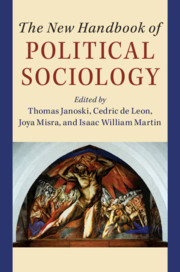Book contents
- The New Handbook of Political Sociology
- The New Handbook of Political Sociology
- Copyright page
- Dedication
- Contents
- Tables
- Figures
- Contributors
- Acknowledgments
- Introduction
- I Theories of Political Sociology
- 1 Power
- 2 Conflict Theories in Political Sociology
- 3 The Promise of Field Theory for the Study of Political Institutions
- 4 Culture in Politics and Politics in Culture
- 5 Political Sociology and the Postcolonial Perspective
- 6 Gender, State, and Citizenships
- 7 Theories of Race, Ethnicity, and the Racial State
- 8 Toward the Convergence of Culture and Political Economy?
- 9 Tasks for the Political Sociology of the Next Ten Years
- II Media Explosion, Knowledge as Power, and Demographic Reversals
- III The State and Its Political Organizations
- IV Civil Society: The Roots and Processes of Political Action
- V Established and New State Policies and Innovations
- VI Globalization and New and Bigger Sources of Power and Resistance
- Index
- References
7 - Theories of Race, Ethnicity, and the Racial State
from I - Theories of Political Sociology
Published online by Cambridge University Press: 22 February 2020
- The New Handbook of Political Sociology
- The New Handbook of Political Sociology
- Copyright page
- Dedication
- Contents
- Tables
- Figures
- Contributors
- Acknowledgments
- Introduction
- I Theories of Political Sociology
- 1 Power
- 2 Conflict Theories in Political Sociology
- 3 The Promise of Field Theory for the Study of Political Institutions
- 4 Culture in Politics and Politics in Culture
- 5 Political Sociology and the Postcolonial Perspective
- 6 Gender, State, and Citizenships
- 7 Theories of Race, Ethnicity, and the Racial State
- 8 Toward the Convergence of Culture and Political Economy?
- 9 Tasks for the Political Sociology of the Next Ten Years
- II Media Explosion, Knowledge as Power, and Demographic Reversals
- III The State and Its Political Organizations
- IV Civil Society: The Roots and Processes of Political Action
- V Established and New State Policies and Innovations
- VI Globalization and New and Bigger Sources of Power and Resistance
- Index
- References
Summary
A systemic racism approach to understanding racial states like the United States is well-validated in much historical and contemporary social science research. Here we emphasize a number of the key contributions of this contemporary approach to assessing the US racial state. We use “state” to mean a socially and territorially bounded community with a national government complex and many local government institutions. We include aspects of the state accented by the classical theorist Max Weber – national states’ territorial sovereignty and their monopolization of coercion – and also the state’s executive bureaucracy, legislatures, courts, legal norms, and overall political operations (2015 [1919]).
Keywords
- Type
- Chapter
- Information
- The New Handbook of Political Sociology , pp. 191 - 215Publisher: Cambridge University PressPrint publication year: 2020



